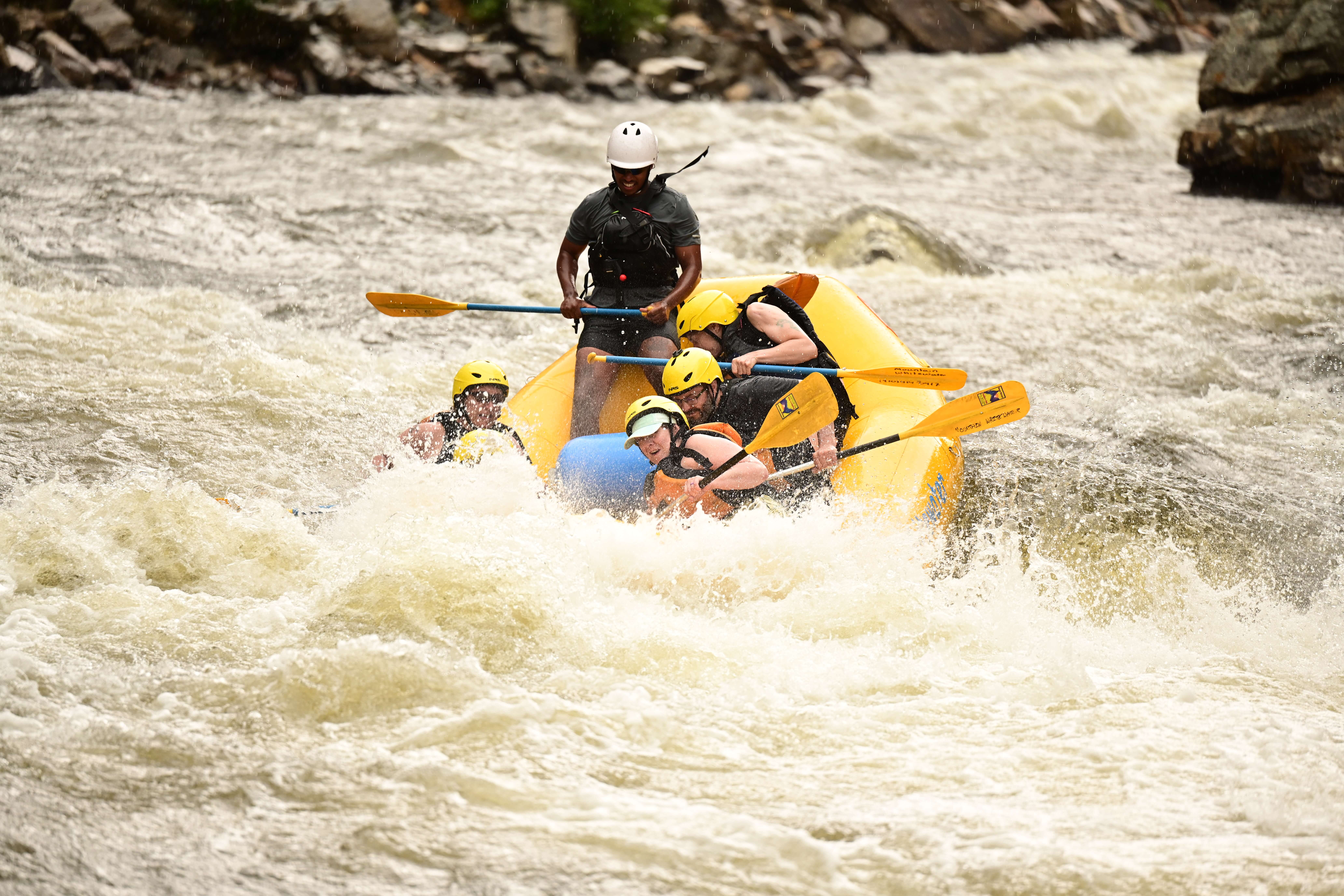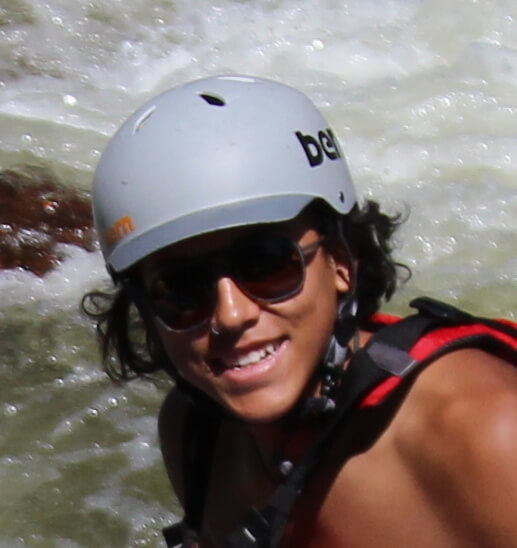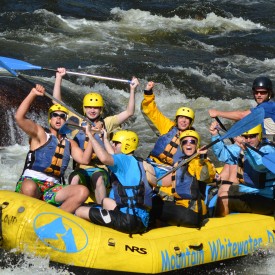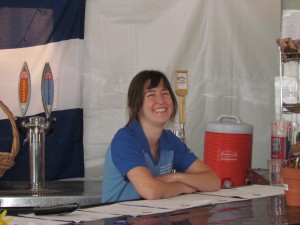Raft Guide Training School 2024 | Mountain Whitewater

by Lindsey Modesitt, January 2024
Are you looking for a challenging, active, and rewarding career in the outdoors? If so, raft guide training school at Mountain Whitewater is perfect for you. Become a certified raft guide in the State of Colorado and earn the chance to be part of the Mountain Whitewater team by enrolling in our 2024 guide school.
Schedule & Materials
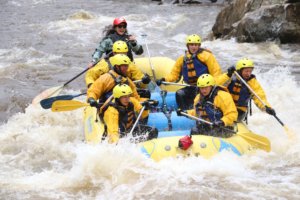 The course starts at 8:00 am on Monday, May 20th, 2024. The first week will consist of classroom sessions in the mornings. Classroom sessions will last until around noon, followed by on-river training in the afternoons (river level permitting). These classroom sessions will consist of a compilation of videos, slides, handouts, lectures, and quizzes. All dry-land instruction and classroom sessions take place on the grounds at Mountain Whitewater.
The course starts at 8:00 am on Monday, May 20th, 2024. The first week will consist of classroom sessions in the mornings. Classroom sessions will last until around noon, followed by on-river training in the afternoons (river level permitting). These classroom sessions will consist of a compilation of videos, slides, handouts, lectures, and quizzes. All dry-land instruction and classroom sessions take place on the grounds at Mountain Whitewater.
Trainees will receive a training packet containing materials related to the course. The packets include all the required materials from the State of Colorado and Mountain Whitewater. The packets will serve as a guide throughout the course. Professionally Guiding Whitewater and The Complete Whitewater Rafter will be used as the main texts for the course and will be loaned to you for the duration of the course. Other books, videos, and other rafting-related materials are available to trainees through the Mountain Whitewater library.
The classroom sessions that are required by the State of Colorado to obtain your guide license are listed below. They will help visualize what is happening on the river and to understand why the boat acts a certain way in rapids. Classes are held early in the training process so that the skills learned in the classroom can be applied to the river.
- Monday, May 20th – 8 am: Paperwork, Employee Handbook, Equipment & Gear, Rigging
- Tuesday, May 21st – 9 am: River Currents, River Features, Paddle Commands, rating scales
- Wednesday, May 22nd – 9 am: Running the Rapids, Safety, Safety Talk, River Hazards
- Thursday, May 23rd – 9 am: River Rescue, Emergency Procedures, Rope Rescue
- Friday, May 24th – 9 am: Miscellaneous, Outdoor Impacts, How to be a Better Guide
Requirements
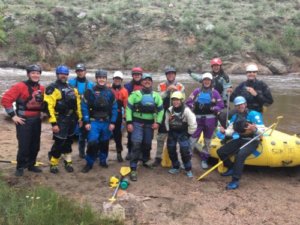
All trainees are required to meet the following criteria to become a raft guide at Mountain Whitewater.
- Must be at least 18 years of age
- Must be able to attend all the above-listed class sessions
- Complete 100+ hours of on-river training required by Mountain Whitewater
- Must complete the Mountain Whitewater Rapid Check-off Sheet
- Must pass a basic First Aid and CPR class if not currently certified. Mountain Whitewater will host a class for staff and trainees sometime in the spring.
- Must complete the Mountain Whitewater Swiftwater Rescue class (included in training investment)
- Must pass a top to bottom check-out run with a trainer
- Treat the training course as if it were a very long job interview to show why you deserve to be part of the Mountain Whitewater team.
Instructors
There will be three main guide trainers; however, we will also have some of our returning guides help with training and instruction as well.
 Brad Modesitt (Owner), 24rd-year guide, Canyons Inc. River Rescue Course, Emergency Medical Technician-Basic (trained), Outdoor Emergency Care Technician, Wilderness First Responder. Brad Modesitt is from Michigan but has lived in Colorado most of his life. Privately he has boated on four continents while pursuing his passion of traveling. He has over 24,901 river miles which is the circumference of the earth! His favorite trip so far has been canoeing to New Orleans and then bicycling to Chile.
Brad Modesitt (Owner), 24rd-year guide, Canyons Inc. River Rescue Course, Emergency Medical Technician-Basic (trained), Outdoor Emergency Care Technician, Wilderness First Responder. Brad Modesitt is from Michigan but has lived in Colorado most of his life. Privately he has boated on four continents while pursuing his passion of traveling. He has over 24,901 river miles which is the circumference of the earth! His favorite trip so far has been canoeing to New Orleans and then bicycling to Chile.
Justin “Baby J” Romero- Justin grew up in Fort Collins where he explores the mountains. Justin Graduated from Colorado State University in December with a degree in Forestry and Rangeland Management. He enjoys spending time in a hammock in the mountains and listening to the wind whip through the trees. When not on the river, Justin can be found eating burritos and listening to rock ‘n roll. He likes fishing, hunting, hiking snowboarding and many other things. He is trained in SwiftWater Rescue Techniques. This is Justin’s 5th year guiding on the Cache La Poudre
 Evandel “Vano” Crabtree- Vano is from Dayton, Ohio where he grew up playing football and running track. He graduated from Sinclair College in Dayton, Ohio. Vano’s next adventure was to follow his heart and chase his passion for rafting. That passion found him in Fort Collins, Colorado. Vano’s love for rafting came from rafting trips as a kid in West Virginia. After discovering that guides were like superheroes, he decided that would be a perfect fit for him, we agreed. Vano is a SwiftWater trained and this is his 4th year as a guide on the Poudre River.
Evandel “Vano” Crabtree- Vano is from Dayton, Ohio where he grew up playing football and running track. He graduated from Sinclair College in Dayton, Ohio. Vano’s next adventure was to follow his heart and chase his passion for rafting. That passion found him in Fort Collins, Colorado. Vano’s love for rafting came from rafting trips as a kid in West Virginia. After discovering that guides were like superheroes, he decided that would be a perfect fit for him, we agreed. Vano is a SwiftWater trained and this is his 4th year as a guide on the Poudre River.
Also assisting with Training for 2024
Matt Troyanek, Coe Stemple, Casey Batezel, Jack Reed, Melissa Matsunaka, Jacque “tiny” McVey, Casey Kramer
How to Apply
Training Investment: $395. Taking the class is not a guarantee of a job, but all new guides will be hired from the training class. If hired, half of the class fee is returned after the second full-time season working with Mountain Whitewater, the other half is returned after the third full-time season working with Mountain Whitewater. This cost covers the classroom sessions, dry-land sessions, equipment used during training (PFD, wetsuit, booties, splash jacket, and helmet), Swiftwater rescue class, and transportation to and from the Cache La Poudre River Canyon. Being a river guide is a multidimensional job requiring both physical skills and an outgoing personality. We are looking for people who can fulfill those needs. Ask around…we have the best-trained guides you will find.
If interested, contact us at contacts@raftmw.com or by calling 970-419-0917.
History of Whitewater Paddling | Mountain Whitewater

Original text by Jed Policky in July, 2001. Eddited by Ben Costello in February, 2018
The Origin of Kayaks and Canoes in North America
- the Inuit and other people native to the Arctic Regions of North America and Greenland designed the first kayaks and canoes in North America. However, these kayaks were not made to run rivers like the ones that we run today. These native kayaks were made for use in the open seas to carry loads and for hunting.
Native Kayaks and Canoes Closer to Home
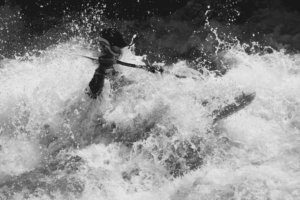
- Native Americans had canoes made of bark, particularly birch bark in the 1700s. Although these canoes were primitive, there was great skill put into their design and construction. They were designed for various water conditions such as rapid streams, quiet waters, lakes, and along the coast.
- During this same time period, the fur trade was developing and expanding across North America. At this time, European trappers and fur traders started using kayaks and canoes. They first purchased the bark canoes form the native builders. Later, French craftsmen began to build their own canoes with wooden frames on the inside for the internal structure and canvas on the outside to form the shell.
The Beginnings of Whitewater Navigation
- The first attempt to navigate a whitewater river happened in 1811. The group attempting the journey on the Snake River in Wyoming found they did not have proper equipment or skills, so the river was deemed too difficult to run.
- The first rubber raft was built in 1840 by Lt. John Freemont and Horace Day in order to survey the Rocky Mountains via the Snake River. The expedition and raft failed due to the rough waters.
Early Colorado River Expeditions
- In 1869 and 1871, John Wesley Powell led the first two expeditions down the length of the Colorado River. The trips were an effort to produce a systematic and scientific survey of the Colorado River drainage system. Powell’s exploration of Colorado’s Rivers not only helped develop and expand the west; it sparked the imagination for further whitewater exploration. Powell used wooden boats on his journeys, making for a very difficult endeavor. Powell’s expeditions set the precedent for commercial river running which started out using wooden boats.
The Popularity of River Running Increases
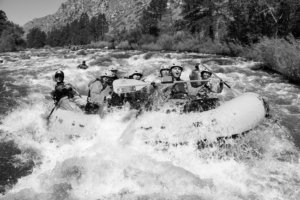
- Paddling had been a recreational activity in both the US and Europe since the early 1900s, but it wasn’t until the 1940s that the first major advancements began to develop. With new materials, such as fiberglass and aluminum to make kayaks and canoes and synthetic rubber for rafts, river activities started to increase in popularity, though the number of participants was still small compared to today’s standards. Rafts were also available through war surplus stores, which created an increase in the number of people rafting. This increase of rafting mainly was focused in the west and opened many boundaries for running whitewater.
- The first successful whitewater rafting expedition took place in July of 1940. Clyde Smith was able to navigate the Snake River Canyon in a homemade rubber raft.
- The 1st Annual Royal Gorge Boat Race was held in 1949 in Salida, Colorado. It is now the oldest whitewater race in the Western Hemisphere
Paddling in the 1950s
- Kayakers invented the “Eskimo Roll” in the 1950s. This is the technique that allows for kayakers to right themselves after flipping over without leaving their boat.
- Many boaters improved their technique and skills due to new boat designs and new materials. This revolution gave way to many 1st descents of rivers in the US.
- The scale for rating rapids that we still use today was developed in the 1950s. The International Scale was developed by the American Whitewater Association to rate rivers from Class I-VI. Class I being the easiest, and class VI as the hardest.
- Some of the first commercial raft trips were run out of a lodge John D. Rockefeller, Jr. built in Grand Teton National Park. The float trips used surplus war rafts that were 27 ft long. Less than 500 people went that first year.
River Conservation and More Innovation in the 1960s
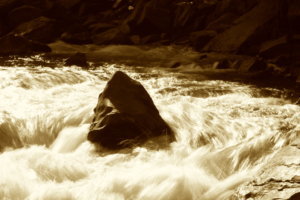
- As technique and boat design continued to improve during the 1960s, the difficulty level of rivers being run increased.
- The number of people participating in commercial rafting trips increased greatly during the 1960s with the growing number of river outfitters.
- The first commercial rafting companies running the Grand Canyon began in the 1960s. Some companies used the then-new large rubber rafts. Others used wooden dories that harken back to the Powell era.
- During this same time period, many rivers were beginning to be damned for hydroelectric power, irrigation, or for water storage in reservoirs. Many rivers were changed or even lost forever due to dams being built. Conservation of rivers became an important national topic of concern among boaters and conservationists. On Oct. 2, 1967, the Wild and Scenic Rivers Act was passed. The National Wild and Scenic Rivers System was established a year, protect rivers from dam building and preserving the free-flowing nature of some of our nations most popular and pristine rivers.
Whitewater Paddling Popularity Booms
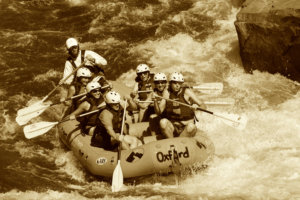
- Movies, like Deliverance that was released in 1972, brought whitewater paddling to a more mainstream and widespread audience.
- Whitewater sports were included in the ’72 Olympics in Augsburg, Germany.
- Playboating began during this period. Kayakers started surfing waves and playing in holes rather than running rivers. Playboating was made possible by the invention of the plastic kayak, which is a lot more durable than previous versions.
- As whitewater sports moved from a club sport to a more mainstream activity, a market for everything from boats to equipment to guidebooks grew.
- The threat of damn building also increased which resulted in increased legislation and regulation of rivers.
Whitewater Paddling Grows Up
- Whitewater became a full-fledged industry with many new innovations in the 1980s.
- The introduction of dry suits extended the boating season to colder parts of the year.
- A new form of kayaks called squirt boats was introduced.
- The most important innovation for rafting in this era was the introduction of self-bailing floors. Rafts before this time had sealed floors that held water inside the boat. The water then had to be bailed out of the raft. Thus, self-bailing floors made rafting whitewater easier and made it safer to run more difficult rapids.
- Different types of media, from books to videos, grew for purposes such as instruction, entertainment, and even promotion (Mountain Dew).
- the 1980s saw a huge increase in the number of participants in whitewater recreation. The increase resulted in an increase in dam building and river access issues.
- In 1986, the upper 75 miles of the Cache La Poudre River were designed by Congress as “Wild & Scenic.” The designation meant that this section of the river was protected from further water projects and dams to preserve its free-flowing nature. The designation also put the United States Forest Service in charge of permitting and regulating the river.
The ‘90s and beyond.
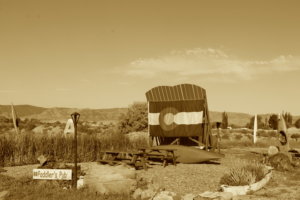
- At the beginning of the 1990s an estimated 14.8 million people participated in whitewater rafting and kayaking. This is a big jump form whitewater’s humble beginning as a club sport with a very limited number of participants. Many components can be attributed to the industries success including new magazines, TV shows, videos and movies, Internet, and competitions such as the X-Games.
- Whitewater sports were included in the 1992 Barcelona Olympics and the 1996 Atlanta Olympics.
- The International Federation of Rafting was established in 1997. The first rafting world championships were held in 1999.
- Mountain Whitewater was founded in 2000.
- Almost 5.5 milion people went on a commercial rafitng trip between 2006 and 2016 in Colorado.
Wild & Scenic Rivers Act 50th Anniversary

by Ben Costello, April 2018
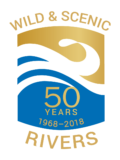
2018 marks the 50th anniversary of the Wild & Scenic River Act which was enacted by Congress on October 2, 1968. The anniversary of this landmark legislation brings the opportunity for us to celebrate wild, free-flowing rivers and the impact that these rivers have on our lives. We are very fortunate in Fort Collins, that we live next to the only Wild & Scenic River in Colorado, the Cache La Poudre. The Poudre River is near and dear to many in Northern Colorado. I believe it is the lifeblood of our community and our most important natural resource. Let’s take time in 2018 to celebrate the Cache La Poudre, spend time in or near its waters, and make sure we truly understand how positively it impacts our wellbeing.
The Wild & Scenic River Act
The Wild & Scenic Rivers Act is an extremely important piece of legislation because it protects the character of our best free-flowing rivers. Free-flowing rivers are the most healthy ecologically of any river systems and provide for the most impactful recreational experiences. The act allows for management of the rivers for public enjoyment and prevents the rivers from being dammed. It also promotes public involvement in setting goals for rivers while also promoting management that crosses over political boundaries.
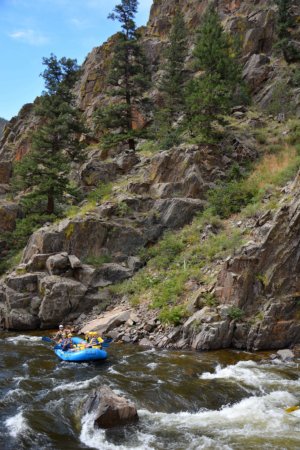
Section 1, (b) of the “Wild and Scenic Rivers Act” states, “It is hereby declared to be the policy of the United States that certain selected rivers of the Nation which, with their immediate environments, possess outstandingly remarkable scenic, recreational, geologic, fish and wildlife, historic, cultural, or other similar values, shall be preserved in free-flowing condition, and that they and their immediate environments shall be protected for the benefit and enjoyment of present and future generations.”
Section 2 (b) of the “Wild and Scenic River Act” states rivers “shall be classified, designated, and administered as one of the following:
- (1) Wild river areas – Those rivers or sections of rivers that are free of impoundments and generally inaccessible except by trail, with watersheds or shorelines essentially primitive and waters unpolluted. These represent vestiges of primitive America.
- (2) Scenic river areas – Those rivers or sections of rivers that are free of impoundments, with shorelines or watersheds still largely primitive and shorelines largely undeveloped, but accessible in places by roads.
- (3) Recreational river areas – Those rivers or sections of rivers that are readily accessible by road or railroad, that may have some development along their shorelines, and that may have undergone some impoundment or diversion in the past.”
The Wild & Scenic Rivers System
Today, the National Rivers System protects 12,734 miles of 208 rivers in 40 states and the Commonwealth of Puerto Rico. This is less than one-quarter of one percent of the nation’s rivers. By comparison, more than 75,000 large dams nationwide have modified at least 600,000 miles, or about 17%, of American rivers.*
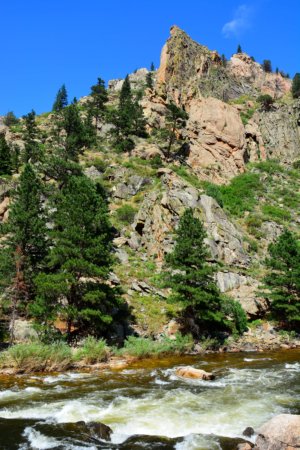
Key Facts:
1. Designation as a Wild & Scenic River does not prohibit development or give the federal government control over private property. Recreation, agricultural practices, residential development and other uses can continue (See detailed FAQs here).*
2. Rivers, or sections of rivers that are designated as ‘Wild’, ‘Scenic’, or ‘Recreational’ are protected through voluntary stewardship by landowners and river users, and through regulation and programs of federal, state, local or tribal governments.*
3. Not all land within the boundaries of designated rivers is, or will be, publicly owned, and the Act limits how much land the federal government is allowed to acquire from willing sellers.*
4. The Act strives to balance dam and other construction at appropriate sections of rivers with permanent protection for some of the country’s most outstanding free-flowing rivers. To accomplish this, it prohibits federal support for actions such as the construction of dams or other in-stream activities that would harm the river’s free-flowing condition, water quality or ‘outstandingly remarkable’ resource values.*
5. Designation does not affect existing water rights or the existing jurisdiction of states and the federal government over waters as determined by established principles of law.*
The Wild & Scenic Cache La Poudre River
On October 30, 1986, portions of the Cache La Poudre River were designated for protection under the Wild & Scenic Rivers Act. The State of Colorado has approximately 107,403 miles of river, of which 76 miles are designated Wild & Scenic. That is less than 1/10th of 1% of the state’s river miles. All 76 of those designated river miles are found in the Cache La Poudre watershed. The main stem of the Poudre from its source at Poudre Lake to Hewlett Gulch Bridge is protected, as well as the South Fork of the Poudre from its source to the confluence with the main stem. 30 miles of the 76 designated miles are considered ‘Wild’ while the remaining 46 miles have a ‘Recreational’ designation.
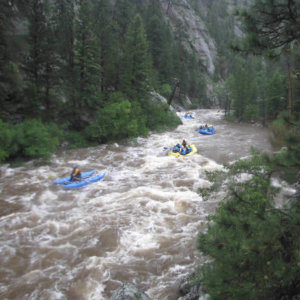
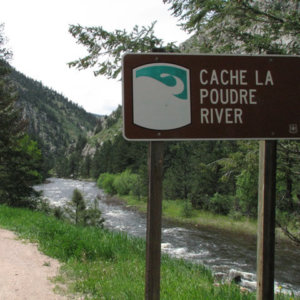
Referrences & Resources
– Wild & Scenic Rivers 50th Anniversary Website, https://www.rivers.gov/wsr50/index.php
– 5,000 miles. 5,000 stories. One Unified Voice for our Nations Rivers, https://www.5000miles.org
– Wild & Scenic Rivers Flicr page, https://www.flickr.com/photos/wild_rivers/
– Cache La Poudre River “Wild & Scenic River” Map, https://www.rivers.gov/rivers/cache-la-poudre.php
*from Wild & Scenic River Act 50th Anniversary press kit, http://wsr50.onlinepresskit247.com
Raft Guide Training with Mountain Whitewater
Whitewater raft guide training offers the chance to learn the skills needed to be a certified guide in the Sate of Coloradoand the chance to earn a job with the best rafting outfitter on the Cache La Poudre River.
by Ben Costello, January 2016
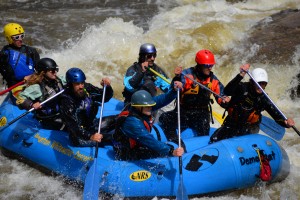
This year’s raft guide training will start on Monday, May 16, 2016. The first week of the course will consist of classroom style training at Mountain Whitewater in the mornings with on-river training in the afternoons. These classroom sessions will consist of a compilation of videos, slides, handouts and lecture.
The following weeks of the course consist of mostly on-river training. We will take two trips per day, seven days per week to complete the state mandated number of hours required to be a guide. There is a Swiftwater rescue training and a CPR and First Aid course during this period of guide training. We will be doing some intense training so that we can get you on the river as soon as possible.
Class Schedule for the 2016 Raft Guide Training Course
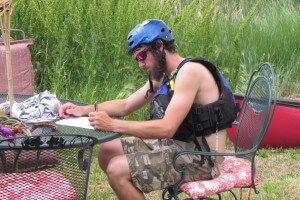
- Monday, May 16th – Paperwork, Employee Handbook, Equipment & Gear Rigging
- Tuesday, May 17th – River Currents, River Features, Paddle Commands, rating scales
- Wednesday, May 18th – Running the Rapids, Safety, Safety Talk, River Hazards, Poudre Bloopers Video, Slammin’ Salmon Video
- Thursday, May 19th – River Rescue, Emergency Procedures, Heads-Up Video, Rope Rescue
- Friday, May 20th – Miscellaneous, Outdoor Impacts, How to be a Better Guide
Other Requirements
- Colorado State law requires that guides have First Aid and CPR certifications. Classes are usually between $50 and $80.
- The Mountain Whitewater Swiftwater Rescue class will also be a required part of guide training. The cost of the Swiftwater Rescue course is included in the training investment.
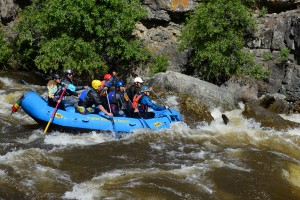
- The State of Colorado requires that you have 50 hours on river time before you can guide commercially.
- Mountain Whitewater will require that you have 100+ hours.
- We will have a Poudre rapids check-off sheet that will require all trainees to run all of the rapids of the Poudre Plunge at least 5 times.
- Once complete, if deemed appropriate, there will be a check-off run, top to bottom, with customers and a trainer in the boat. If all goes well, you will now be part of the Mountain Whitewater team.
Training Investment
The cost for the course is $395 (half is returned after the second fulltime season working with Mountain Whitewater, half returned after the third fulltime season working with Mountain Whitewater).
This cost covers the classroom sessions, dry land sessions, equipment used during training (PFD, wetsuit, booties, splash jacket, and helmet), swiftwater rescue class and transportation to and from the Cache la Poudre River Canyon.
Being a river guide is a multidimensional job. It is physically and mentally demanding, days can be long with exposure to the elements. It is also very rewarding and tons of fun. We are looking for people who can fulfill those needs. Ask around…Mountain Whitewater has the best trained guides you will find. Call 970-419-0917 if interested or email contacts@raftmw.com.
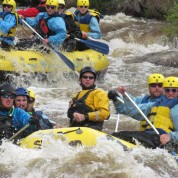
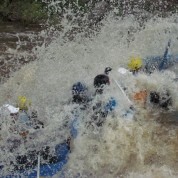
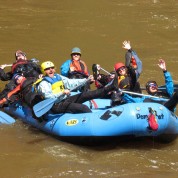
Third Annual Poudre River Forum – February 5, 2016
The third annual Poudre River Forum theme is Cultivating Connections for a
Healthy, Working River.
by Ben Costello, January 2016
The Poudre Runs Through It is a study/action work group dedicated to all things concerning the Cache La Poudre River. The group is made up of about 25 citizen experts representing a diversity of interests who were selected to study the Poudre River and formulate cooperative actions based on what they learn. One of those members is Brad Modesitt, Owner of Mountain Whitewater. The goal of the group is to build relationships and to put in action the initiatives they have identified, “to make the Poudre River the world’s best example of a working river that’s also healthy.”
The groups flagship event, The Third Annual Poudre River Forum will take place on February 5, 2016 and will be held at The Ranch in Loveland from 9am to 4pm. This years event theme is Cultivating Connections for a Healthy, Working River. The event will feature several different informational sessions and discussions surrounding the current state of the Poudre River. I have been able to attend the past two years and the event is very informative and well worth attending. It is important for anyone who cares about the Cache La Poudre River to be involved with groups and events like this as the river is the lifeblood of our Front Range communities.
The event will also include sponsor booths, door prizes including a rafting trip from Mountain Whitewater, networking opportunities, lunch, fun videos, and a closing celebration with music from Blue Gramma and beer from Odell Brewing Company. This will be a great event and I hope to see you all there!
Register for the event here: http://cwi.colostate.edu/ThePoudreRunsThroughIt/forum_2016.shtml
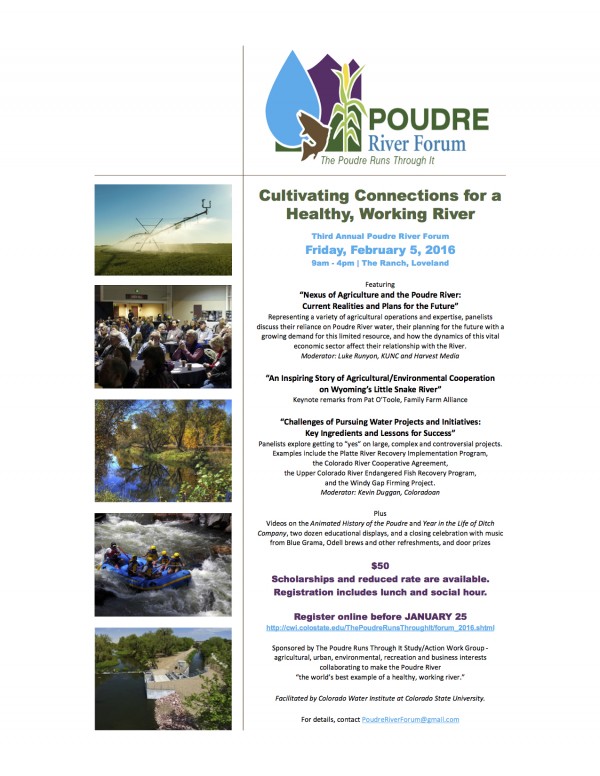
Team Building the Mountain Whitewater Way
Group whitewater rafting trips are the perfect activity for an impactful and worthwhile team building experience for any business or corporate group.
by Ben Costello, December 2015
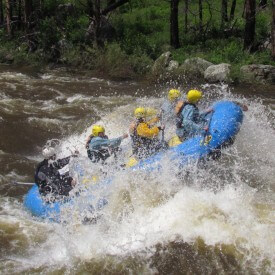 Team building outings are a very important tool for managers, corporate officers, team leaders and business owners in developing a high-quality, professional staff. Most employees are more comfortable in a work place where we get along with our coworkers and can understand and relate to each other more effectively. Shared experiences through team building, especially those that take place in an unfamiliar setting, can help facilitate positive bonds between coworkers. Don’t waste time gathering in an onsite meeting room to try and build team camaraderie. Team building is a lot more effective when you take people out of their normal environment and put them in a situation that encourages them to break out of their shell. A whitewater rafting trip with coworkers provides the ideal scenario to build a cohesive team.
Team building outings are a very important tool for managers, corporate officers, team leaders and business owners in developing a high-quality, professional staff. Most employees are more comfortable in a work place where we get along with our coworkers and can understand and relate to each other more effectively. Shared experiences through team building, especially those that take place in an unfamiliar setting, can help facilitate positive bonds between coworkers. Don’t waste time gathering in an onsite meeting room to try and build team camaraderie. Team building is a lot more effective when you take people out of their normal environment and put them in a situation that encourages them to break out of their shell. A whitewater rafting trip with coworkers provides the ideal scenario to build a cohesive team.
So why is rafting such a great activity to facilitate worthwhile team building? Simple. Whitewater rafting is a natural team building activity. Getting six or seven people to work together and paddle in unison to get a raft through the rapids requires teamwork, leadership, cooperation and communication. Everyone from the owner and managers to the newest employees must contribute equally to paddling for a successful run through any rapid.
Skills used during a rafting trip can be applied to many different scenarios at work. In a successful workplace, everyone needs to paddle towards common goals. The more efficiently everyone paddles together towards a common goal, the easier that goal is to achieve.
As a rafting trip travels down the river it will encounter many situations that can relate to challenges your team can face. During times of calm waters it is important to remember to take-in the fantastic scenery and not focus on just your own raft. During times of turbulent rapids it is critical for everyone to buckle down and work together to make it through with success.
Following a guides instructions and helping others understand those instructions leads to improved communication. Relying on the paddling skills and effort of your team members builds trust. Collaboration is needed between raft mates to avoid swimmers. Down time between rapids gives everyone the chance to get to know each others back grounds a better through conversation. The action during a rapid helps to identify and respect strengths and weaknesses of team members. The adrenaline of rapids teaches paddlers how to perform in a fast-paced and unpredictable environment. Not to mention the chance to have FUN together. People naturally learn more when they are having fun and tend to remember those learned experiences better when the experiences were enjoyable.
Mountain Whitewater can facilitate a team building trip for groups ranging is size from 14 up to 50 people on any half-day trip. Group rates apply to team building trips as well. Custom programs are also available that include additional exercises and debriefing sessions at Mountain Whitewater.
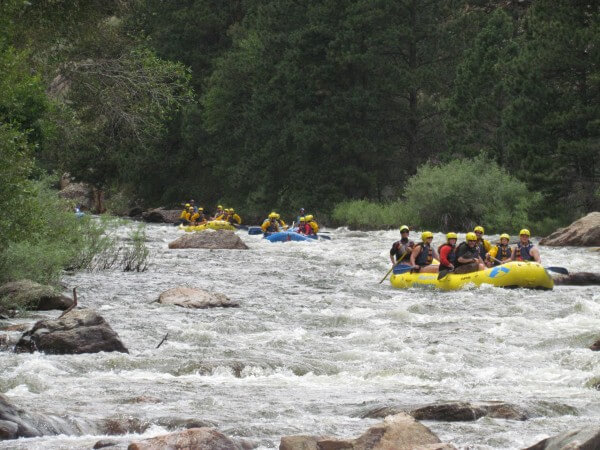
Rafting Team Building: All the rafts on the trips must stay together and work as a team for a trip to make it down the river successfully.
2015 Projected Flow for Poudre River Above Average
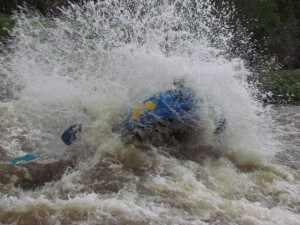 As of March 1, 2015 the Cache La Poudre River spring and summer flow is forecast to be at levels around 103% of average flows. This is according to the Colorado Water Supply Outlook Report issued by the US Department of Agriculture, Natural Resource Conservation Service (NRCS).
As of March 1, 2015 the Cache La Poudre River spring and summer flow is forecast to be at levels around 103% of average flows. This is according to the Colorado Water Supply Outlook Report issued by the US Department of Agriculture, Natural Resource Conservation Service (NRCS).
NRCS issues a monthly report from January to June every year that outlines snowpack levels, precipitation amounts, reservoir storage and stream flow forecasts for the different river basins in the State of Colorado. The Cache La Poudre River is a sub-basin of the larger South Platte River basin that covers most of northeast Colorado on the east side of the continental divide. Overall, the South Platte basin has seen 110% of median snowpack levels this past winter and has the highest on average stream flow forecasts for 2015 for each of its sub-basins (Cache La Poudre, Big Thompson, Boulder-St. Vrain, Clear Creek and Upper South Platte) compared to other basins in the State.
The streamflow forecast for the Cache La Poudre River comes as great news for recreation, as average to high snowpack levels translate to better water conditions. While there is still time for variations in the snowpack levels and ultimately spring and summer streamflows, above average numbers in March usually lead to very exciting peak levels in June and sustained water levels throughout the summer season. Another bit of good news from the report is that reservoir storage levels in the Cache La Poudre basin are also near or above average as well.
“We are very excited to see streamflow forecast near or above 100% of average for the Poudre River. Great water conditions are exciting for our staff and provide for an unforgettable rafting experience for our guests” says Ben Costello, Director of Fun for Mountain Whitewater.
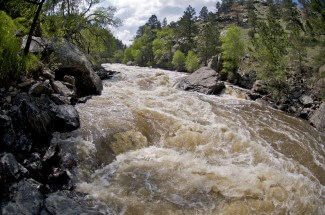 “We are looking forward to another fantastic season and cannot wait to start taking our guests down this very special river.”
“We are looking forward to another fantastic season and cannot wait to start taking our guests down this very special river.”
Whitewater rafting on Colorado’s only “Wild & Scenic River” is always a unique and memorable experience, but good water conditions make things even better. If a fast paced trip is what you seek, be sure to book your 2015 rafting trip in May or June for the most exciting water conditions. As long as we continue to see average snow fall amount in March and April (typically the best months for snow in Colorado), conditions for rafting on the Cache La Poudre River will be fantastic for the entire 2015 river season.
Follow this link to the Basin Outlook Report to read the entire report for yourself or to check on forecast conditions around the rest of our beautiful state.
Mountain Whitewater Finds Success with New Booking Engine
For the summer 2014 whitewater rafting season, Mountain Whitewater was in need of finding a new reservation platform. Our old system worked, but was outdated, not intuitive for users and did not provide the kind of support that we would like. There are a multitude of different reservation software platforms available for tour operators today, but not all work in a way that is convenient for both guests and staff. Our goal was to find a system that allowed our guests to book in an easier, more streamlined way that looked professional and kept feel or our website. After researching different platforms, we found Rezdy and could not be happier.
Booking your adventure on our website is now a breeze. There are less steps to go through for guests, whether booking online or over the phone with our professional staff, which means less time booking your experience and more time enjoying your vacation. Rezdy has also benefited the business by giving our staff more time to focus on providing great customer service that is expected by our guests because they spend less time clicking through screens in the booking software. Rezdy was easy to implement, is easy to use and provides very high quality support.
Thanks to Rezdy for building and maintaining such a useful booking tool. We are excited to provide a worry free way for our guests to book the experience of a lifetime. For more information check this link to our Rezdy case study.
Parts of the river…
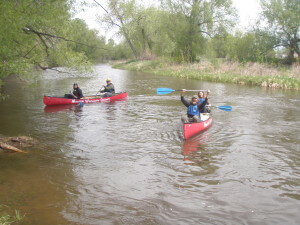 Flow
Flow
“Flow” refers to the water running in a river or stream. There are two important aspects to a river’s natural flow. First, there is the amount of water that flows in the river. Some rivers get enough water from their headwaters, tributaries, and rain to flow all year round. Others go from cold, raging rivers to small, warm streams as the snowpack runs out, or even stop flowing completely. A river’s natural ups and downs are called “pulses.” Like a human being’s pulse, a river’s natural flow of water is life support for animals, plants, and fish, delivering what they need to survive at the right times. When we divert water away from a river, we change the river’s natural flow.
The second component of natural flow is how water moves through a river’s channel. In a natural, wild river, the water runs freely. But in more developed or degraded rivers, dams and other structures can slow or stop a river’s flow. When a river’s flow is blocked, migratory fish like salmon can suffer, unable to move up or downstream.
– From Americanrivers.org
Message to the Congress Proposing Additions to the National Wild and Scenic Rivers and National Wilderness Preservation Systems
April 26, 1985
To the Congress of the United States:
Balancing the development of our Nation’s many natural resources with the need to preserve our national treasures is a formidable challenge. Continued economic growth depends in part upon prudent use of our natural resources. At the same time, we must protect wilderness areas and wild, free-flowing rivers for this and future generations to enjoy in their natural, undeveloped state.
To further this effort and pursuant to the Wilderness Act of 1964 and the Wild and Scenic Rivers Act of 1965, I am today proposing, at the recommendation of the Secretary of the Interior and the Secretary of Agriculture, four additions to the National Wilderness Preservation System and three additions to the National Wild and Scenic Rivers System. These additions total over 382,000 acres of wilderness and nearly 174 river miles.
Briefly described, the proposed additions to the Wilderness System are:
(1) The Powderhorn area, in Gunnison and Hinsdale Counties, Colorado — 43,311 acres of unique subalpine and alpine tundra, most of which is currently managed as the Powderhorn Primitive Area. This area offers exceptional opportunities for primitive and unconfined recreation.
(2) The Great Rift area in Blaine, Butte, Minidoka, and Power Counties, Idaho — 322,450 acres of desert lava flows. This area, part of which is within the Great Rift National Natural Landmark, is an outstanding example of basaltic volcanism.
(3) The Humbug Spires area in Silver Bow County, Montana — 8,791 acres characterized by awesome granite spires and domes. Much of this area was designated as a Primitive Area in 1982.
(4) The Scab Creek area in Sublette County, Wyoming — 7,636 acres of highly scenic rocky bluffs interspersed with small stands of timber and small meadows. This area, in the foothills of the Wind River Range, was designated as a Primitive Area in 1975.
In addition, I am transmitting three legislative proposals to designate the following additions to the National Wild and Scenic Rivers System:
(1) The North Fork Kern River in Tulare County, California — 60.7 miles of the river in the Inyo National Forest and the Sequoia National Park.
(2) The Cache la Poudre River in Larimer County, Colorado — two segments totalling 62 miles of the river in the Roosevelt National Forest and the Rocky Mountain National Park.
(3) The Manistee River in Manistee, Wexford, and Lake Counties, Michigan — two segments totalling 51 miles of the river in the Manistee National Forest.
Pursuant to existing law, the Secretary of the Interior and the Secretary of Agriculture have also concluded that certain areas studied are not suitable for wilderness designation or for inclusion into the national rivers system.
I concur in all of these recommendations, and I am transmitting to the Congress today letters and reports from the Secretaries of the Interior and Agriculture regarding all of these wilderness and rivers proposals. I applaud the Congress for responding to my last wilderness and rivers transmittal in September 1982 by designating the Aravaipa Canyon Wilderness in Arizona, the Paddy Creek Wilderness in Missouri, the Verde Wild and Scenic River in Arizona, and the AuSable Wild and Scenic River in Michigan. I reaffirm my support for the rest of the wilderness and river designations included in my September 1982 transmittal, and urge the Congress to act expeditiously and favorably on those designations as well as the legislative proposals I am transmitting today, so that these precious and irreplaceable resources may be protected and preserved.
Ronald Reagan
The White House,
April 26, 1985.



